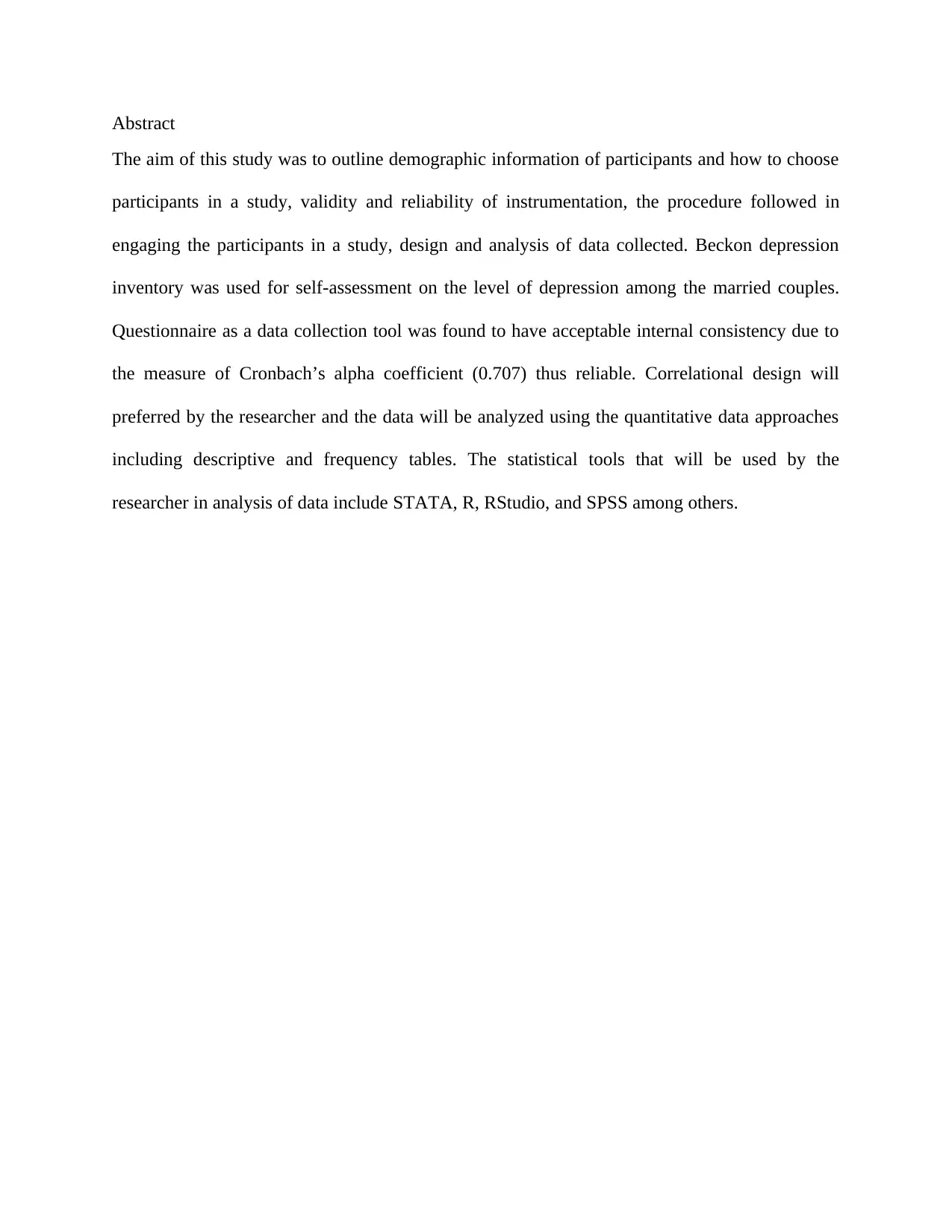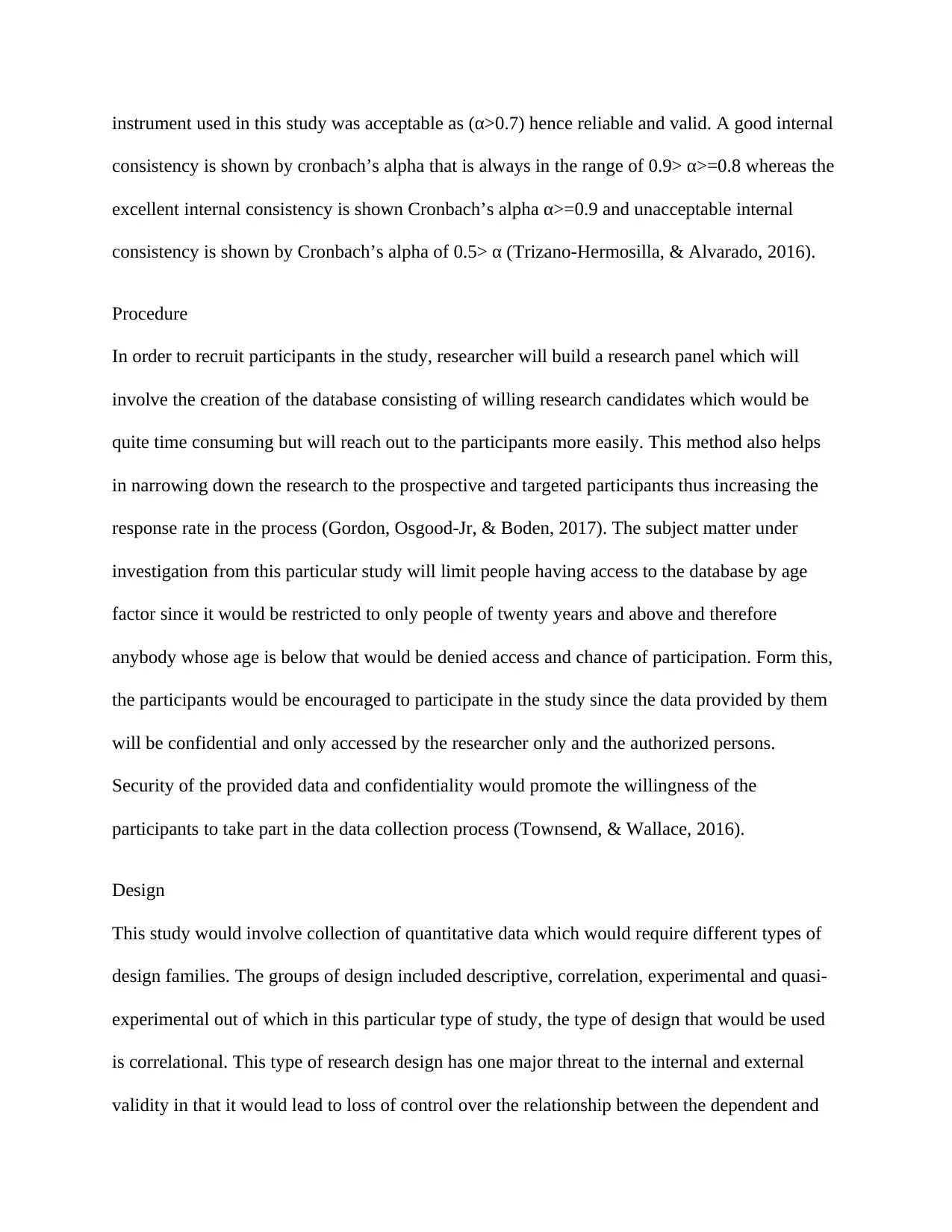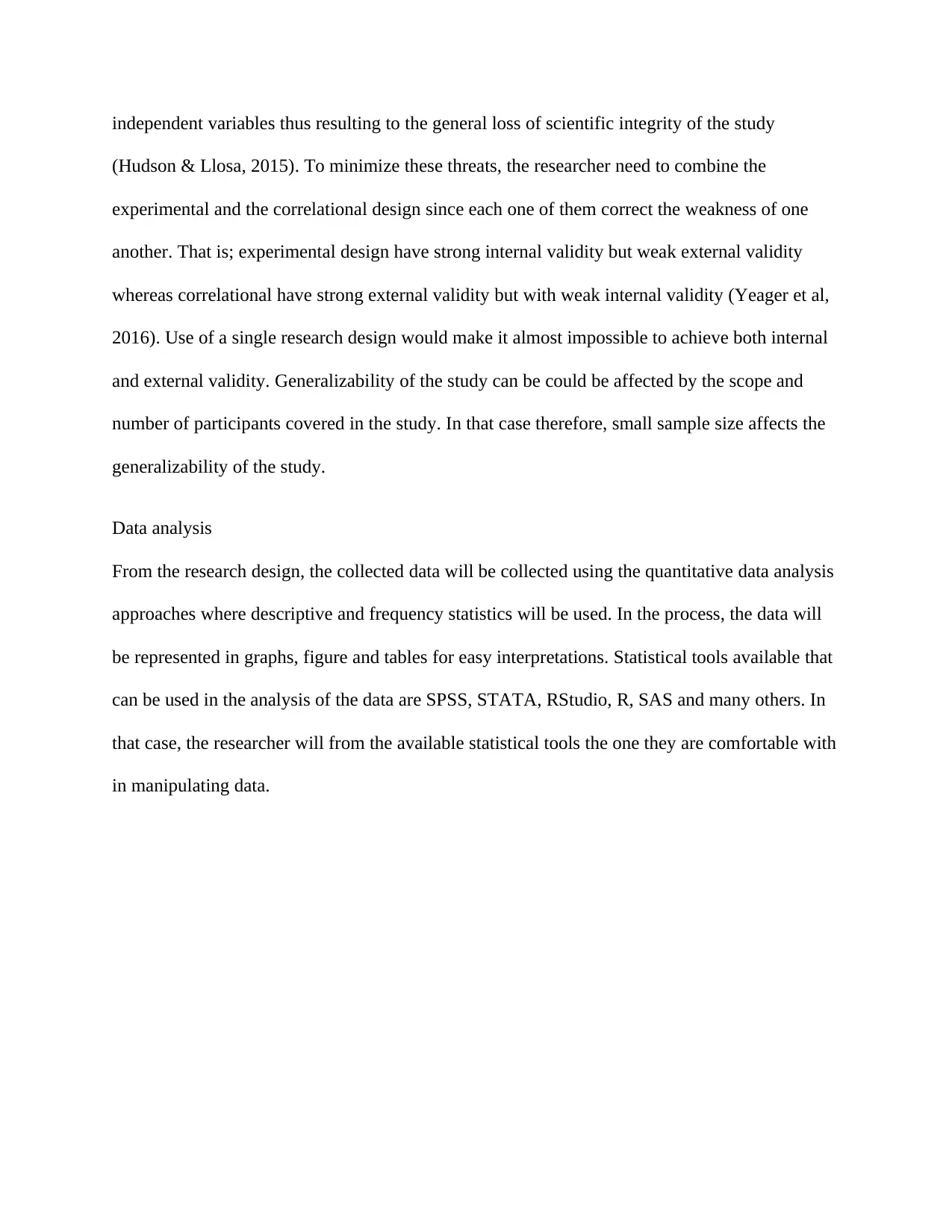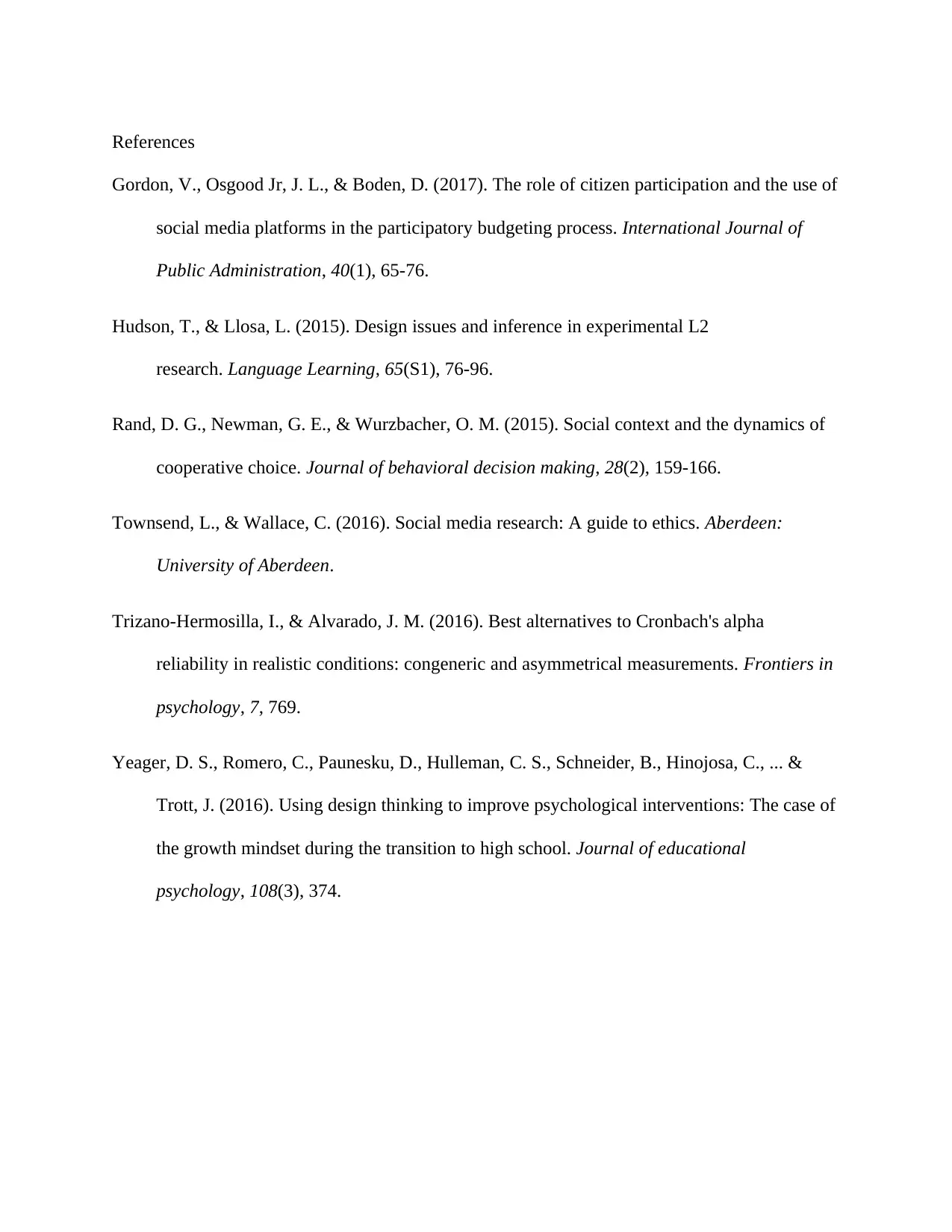Psychology Final Project: Research and Evaluation Report
VerifiedAdded on 2023/01/06
|6
|1318
|32
Report
AI Summary
This report presents a research and evaluation study focusing on the levels of depression among married couples. The study outlines the demographic information of participants, including age, gender, ethnicity, marital status, and education level. Participants were selected based on age, specifically those aged twenty years and over. The study utilized a questionnaire, including the Beck Depression Inventory, as the primary data collection tool, with an acceptable internal consistency (Cronbach’s alpha = 0.707). The research design employed was correlational, with quantitative data analysis approaches, including descriptive and frequency statistics. The data analysis would utilize statistical tools such as STATA, R, RStudio, and SPSS. The report also addresses threats to validity and reliability, and the procedure followed in engaging participants. The study aims to provide insights into depression levels and the factors associated with it among married couples. References to relevant research papers are included.

Research and evaluation
Paraphrase This Document
Need a fresh take? Get an instant paraphrase of this document with our AI Paraphraser

Abstract
The aim of this study was to outline demographic information of participants and how to choose
participants in a study, validity and reliability of instrumentation, the procedure followed in
engaging the participants in a study, design and analysis of data collected. Beckon depression
inventory was used for self-assessment on the level of depression among the married couples.
Questionnaire as a data collection tool was found to have acceptable internal consistency due to
the measure of Cronbach’s alpha coefficient (0.707) thus reliable. Correlational design will
preferred by the researcher and the data will be analyzed using the quantitative data approaches
including descriptive and frequency tables. The statistical tools that will be used by the
researcher in analysis of data include STATA, R, RStudio, and SPSS among others.
The aim of this study was to outline demographic information of participants and how to choose
participants in a study, validity and reliability of instrumentation, the procedure followed in
engaging the participants in a study, design and analysis of data collected. Beckon depression
inventory was used for self-assessment on the level of depression among the married couples.
Questionnaire as a data collection tool was found to have acceptable internal consistency due to
the measure of Cronbach’s alpha coefficient (0.707) thus reliable. Correlational design will
preferred by the researcher and the data will be analyzed using the quantitative data approaches
including descriptive and frequency tables. The statistical tools that will be used by the
researcher in analysis of data include STATA, R, RStudio, and SPSS among others.

Participants’ description
Demographic information of the participants included age, gender, ethnicity, marital status and
education level. Male participants were represented by 43.3% against female 567%. Age of the
participants were divided into age brackets where 20-29 years represented by 23.3%, 30-39
represented by 46.7%, 40-49 represented by 20% and fifty and over represented by 6.7%. For the
levels of education, elementary level was represented by 20%, secondary level 23.3% and
tertiary level 56.7%. Participants who were single were represented by 10%, divorced 10%,
married 73.3% and separated 6.7%. Furthermore, the ethnicity of the participants included black
43.3% and white 56.7%.
The participants were chosen depending on the age such that the range was twenty years and
over to research on the level of depression on married couples. The maturity age was opted for
because they were expected to have been married and it was a matter of concern to consider. The
choice of participants to involve in the study depends on the subject matter under investigation,
objectives to meet, plans and approaches to be used in the study (Rand, Newman, &
Wurzbacher, 2015).
Instrumentation
Questionnaire was used as a tool of data collection. The questions contained in the questionnaire
were both open ended and closed ended for demographic information part and closed ended
questions for the level of depression part. Beck depression inventory was used with each item
containing four Likert scale. Examples of the questions used in the questionnaire included “what
is your age?” state in a scale by cycling on how you feel towards guilt. The research instrument
used had the Cronbach’s alpha of (α =0.707). This means that the internal consistency of the
Demographic information of the participants included age, gender, ethnicity, marital status and
education level. Male participants were represented by 43.3% against female 567%. Age of the
participants were divided into age brackets where 20-29 years represented by 23.3%, 30-39
represented by 46.7%, 40-49 represented by 20% and fifty and over represented by 6.7%. For the
levels of education, elementary level was represented by 20%, secondary level 23.3% and
tertiary level 56.7%. Participants who were single were represented by 10%, divorced 10%,
married 73.3% and separated 6.7%. Furthermore, the ethnicity of the participants included black
43.3% and white 56.7%.
The participants were chosen depending on the age such that the range was twenty years and
over to research on the level of depression on married couples. The maturity age was opted for
because they were expected to have been married and it was a matter of concern to consider. The
choice of participants to involve in the study depends on the subject matter under investigation,
objectives to meet, plans and approaches to be used in the study (Rand, Newman, &
Wurzbacher, 2015).
Instrumentation
Questionnaire was used as a tool of data collection. The questions contained in the questionnaire
were both open ended and closed ended for demographic information part and closed ended
questions for the level of depression part. Beck depression inventory was used with each item
containing four Likert scale. Examples of the questions used in the questionnaire included “what
is your age?” state in a scale by cycling on how you feel towards guilt. The research instrument
used had the Cronbach’s alpha of (α =0.707). This means that the internal consistency of the
⊘ This is a preview!⊘
Do you want full access?
Subscribe today to unlock all pages.

Trusted by 1+ million students worldwide

instrument used in this study was acceptable as (α>0.7) hence reliable and valid. A good internal
consistency is shown by cronbach’s alpha that is always in the range of 0.9> α>=0.8 whereas the
excellent internal consistency is shown Cronbach’s alpha α>=0.9 and unacceptable internal
consistency is shown by Cronbach’s alpha of 0.5> α (Trizano-Hermosilla, & Alvarado, 2016).
Procedure
In order to recruit participants in the study, researcher will build a research panel which will
involve the creation of the database consisting of willing research candidates which would be
quite time consuming but will reach out to the participants more easily. This method also helps
in narrowing down the research to the prospective and targeted participants thus increasing the
response rate in the process (Gordon, Osgood-Jr, & Boden, 2017). The subject matter under
investigation from this particular study will limit people having access to the database by age
factor since it would be restricted to only people of twenty years and above and therefore
anybody whose age is below that would be denied access and chance of participation. Form this,
the participants would be encouraged to participate in the study since the data provided by them
will be confidential and only accessed by the researcher only and the authorized persons.
Security of the provided data and confidentiality would promote the willingness of the
participants to take part in the data collection process (Townsend, & Wallace, 2016).
Design
This study would involve collection of quantitative data which would require different types of
design families. The groups of design included descriptive, correlation, experimental and quasi-
experimental out of which in this particular type of study, the type of design that would be used
is correlational. This type of research design has one major threat to the internal and external
validity in that it would lead to loss of control over the relationship between the dependent and
consistency is shown by cronbach’s alpha that is always in the range of 0.9> α>=0.8 whereas the
excellent internal consistency is shown Cronbach’s alpha α>=0.9 and unacceptable internal
consistency is shown by Cronbach’s alpha of 0.5> α (Trizano-Hermosilla, & Alvarado, 2016).
Procedure
In order to recruit participants in the study, researcher will build a research panel which will
involve the creation of the database consisting of willing research candidates which would be
quite time consuming but will reach out to the participants more easily. This method also helps
in narrowing down the research to the prospective and targeted participants thus increasing the
response rate in the process (Gordon, Osgood-Jr, & Boden, 2017). The subject matter under
investigation from this particular study will limit people having access to the database by age
factor since it would be restricted to only people of twenty years and above and therefore
anybody whose age is below that would be denied access and chance of participation. Form this,
the participants would be encouraged to participate in the study since the data provided by them
will be confidential and only accessed by the researcher only and the authorized persons.
Security of the provided data and confidentiality would promote the willingness of the
participants to take part in the data collection process (Townsend, & Wallace, 2016).
Design
This study would involve collection of quantitative data which would require different types of
design families. The groups of design included descriptive, correlation, experimental and quasi-
experimental out of which in this particular type of study, the type of design that would be used
is correlational. This type of research design has one major threat to the internal and external
validity in that it would lead to loss of control over the relationship between the dependent and
Paraphrase This Document
Need a fresh take? Get an instant paraphrase of this document with our AI Paraphraser

independent variables thus resulting to the general loss of scientific integrity of the study
(Hudson & Llosa, 2015). To minimize these threats, the researcher need to combine the
experimental and the correlational design since each one of them correct the weakness of one
another. That is; experimental design have strong internal validity but weak external validity
whereas correlational have strong external validity but with weak internal validity (Yeager et al,
2016). Use of a single research design would make it almost impossible to achieve both internal
and external validity. Generalizability of the study can be could be affected by the scope and
number of participants covered in the study. In that case therefore, small sample size affects the
generalizability of the study.
Data analysis
From the research design, the collected data will be collected using the quantitative data analysis
approaches where descriptive and frequency statistics will be used. In the process, the data will
be represented in graphs, figure and tables for easy interpretations. Statistical tools available that
can be used in the analysis of the data are SPSS, STATA, RStudio, R, SAS and many others. In
that case, the researcher will from the available statistical tools the one they are comfortable with
in manipulating data.
(Hudson & Llosa, 2015). To minimize these threats, the researcher need to combine the
experimental and the correlational design since each one of them correct the weakness of one
another. That is; experimental design have strong internal validity but weak external validity
whereas correlational have strong external validity but with weak internal validity (Yeager et al,
2016). Use of a single research design would make it almost impossible to achieve both internal
and external validity. Generalizability of the study can be could be affected by the scope and
number of participants covered in the study. In that case therefore, small sample size affects the
generalizability of the study.
Data analysis
From the research design, the collected data will be collected using the quantitative data analysis
approaches where descriptive and frequency statistics will be used. In the process, the data will
be represented in graphs, figure and tables for easy interpretations. Statistical tools available that
can be used in the analysis of the data are SPSS, STATA, RStudio, R, SAS and many others. In
that case, the researcher will from the available statistical tools the one they are comfortable with
in manipulating data.

References
Gordon, V., Osgood Jr, J. L., & Boden, D. (2017). The role of citizen participation and the use of
social media platforms in the participatory budgeting process. International Journal of
Public Administration, 40(1), 65-76.
Hudson, T., & Llosa, L. (2015). Design issues and inference in experimental L2
research. Language Learning, 65(S1), 76-96.
Rand, D. G., Newman, G. E., & Wurzbacher, O. M. (2015). Social context and the dynamics of
cooperative choice. Journal of behavioral decision making, 28(2), 159-166.
Townsend, L., & Wallace, C. (2016). Social media research: A guide to ethics. Aberdeen:
University of Aberdeen.
Trizano-Hermosilla, I., & Alvarado, J. M. (2016). Best alternatives to Cronbach's alpha
reliability in realistic conditions: congeneric and asymmetrical measurements. Frontiers in
psychology, 7, 769.
Yeager, D. S., Romero, C., Paunesku, D., Hulleman, C. S., Schneider, B., Hinojosa, C., ... &
Trott, J. (2016). Using design thinking to improve psychological interventions: The case of
the growth mindset during the transition to high school. Journal of educational
psychology, 108(3), 374.
Gordon, V., Osgood Jr, J. L., & Boden, D. (2017). The role of citizen participation and the use of
social media platforms in the participatory budgeting process. International Journal of
Public Administration, 40(1), 65-76.
Hudson, T., & Llosa, L. (2015). Design issues and inference in experimental L2
research. Language Learning, 65(S1), 76-96.
Rand, D. G., Newman, G. E., & Wurzbacher, O. M. (2015). Social context and the dynamics of
cooperative choice. Journal of behavioral decision making, 28(2), 159-166.
Townsend, L., & Wallace, C. (2016). Social media research: A guide to ethics. Aberdeen:
University of Aberdeen.
Trizano-Hermosilla, I., & Alvarado, J. M. (2016). Best alternatives to Cronbach's alpha
reliability in realistic conditions: congeneric and asymmetrical measurements. Frontiers in
psychology, 7, 769.
Yeager, D. S., Romero, C., Paunesku, D., Hulleman, C. S., Schneider, B., Hinojosa, C., ... &
Trott, J. (2016). Using design thinking to improve psychological interventions: The case of
the growth mindset during the transition to high school. Journal of educational
psychology, 108(3), 374.
⊘ This is a preview!⊘
Do you want full access?
Subscribe today to unlock all pages.

Trusted by 1+ million students worldwide
1 out of 6
Related Documents
Your All-in-One AI-Powered Toolkit for Academic Success.
+13062052269
info@desklib.com
Available 24*7 on WhatsApp / Email
![[object Object]](/_next/static/media/star-bottom.7253800d.svg)
Unlock your academic potential
Copyright © 2020–2025 A2Z Services. All Rights Reserved. Developed and managed by ZUCOL.





